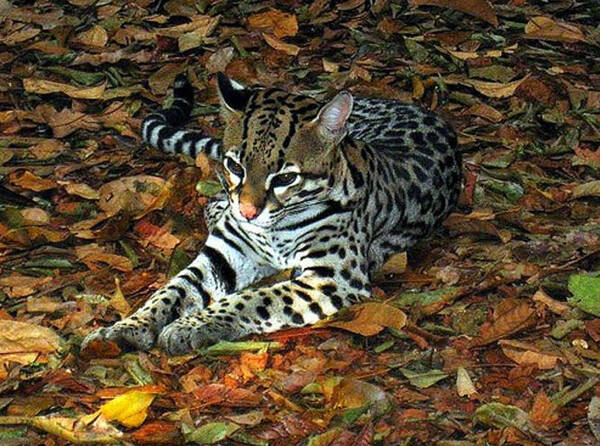Leopardus geoffroyi
IUCN
LCBasic Information
Scientific classification
- name:Leopardus geoffroyi
- Scientific Name:Leopardus geoffroyi,Geoffroy's Cat,Joe's cat, clouded leopard, fishing leopard
- Outline:Carnivora
- Family:Felidae Ocelothrix
Vital signs
- length:42-65cm
- Weight:3-8kg
- lifetime:About 14 years
Feature
Both the southern and northern Joe's ocelots have beautiful patterns.
Distribution and Habitat
Distributed in Argentina, Bolivia, Brazil, Chile, Paraguay and Uruguay.
Inhabits low scrub, riverside forests and rocky wastelands. Mainly inhabits open woodlands or shrublands, and also appears in swampy areas. The areas where it lives are harsh and have a diverse climate: from the windy, barren Bolivian saline plateau at an altitude of 3,000 meters, to the hot central lowlands on the eastern foothills of the Andes in northwestern Argentina, to the Patagonia Plateau in southern Argentina, where sandstorms continue all year round.
Appearance
The size of the Joe's ocelot is similar to that of a domestic cat, with a head and body length of 422-665 mm, a height of 31 cm, a tail length of 31 cm, and a weight of 3-5 kg, with some weighing up to 8 kg. Males are slightly larger. The tail is not too long, about half the length of the body. The size and hair of the Joe's ocelot vary with the distribution area. The Joe's ocelots living in the northern region are smaller in size, with a base color of earthy yellow or yellowish brown. Because they are close to the equator, their hair is shorter than that of the southern ones. Their relatives in southern South America have a silver-gray fur color. Due to the colder climate, their hair is longer and more waterproof, and their fur is denser. However, both the southern and northern Joe's ocelots have beautiful patterns. The whole body is covered with black spots, while the spots on the neck, chest and face merge into horizontal stripes, and the fur color becomes lighte
Details
Geoffroy's Cat (scientific name: Leopardus geoffroyi) is called Geoffroy's Cat in foreign language. There are 5 subspecies.

Geoffroy's Cat is a solitary and secretive nocturnal walker, and it will come out at dawn and dusk. It is a typical arboreal animal, and often looks for food on the ground. It lives alone. They are top predators, at the top of the food chain, and mainly prey on rodents, small birds and bird eggs, lizards, insects, and sometimes frogs and fish. It is a good swimmer and can swim across turbulent rivers, so it also preys on fish.
Joe's ocelots can breed all year round, with the main breeding season from October to March of the following year, and often mate in trees. The gestation period is 72-78 days, and each litter has 2-3 kittens. They can build their nests in bushes, tree holes or rock holes. Females can produce two litters of kittens in a year, with 1-4 pups per litter. Males do not help raise the cubs. When the cubs are born, they are covered with spotted fur and weigh about 65-95 grams. It will take about 10 days for them to open their eyes, and they can climb trees very skillfully when they are about 6 weeks old. Females reach sexual maturity at around 18 months, while males take about 2 years. The life span of a captive Ocelot is 14 years.
In the 20th century, about 150,000 Ocelots were slaughtered every year. In order to make a coat, at least 25 adult Ocelots were sacrificed. The rampant fur trade has affected the survival of Ocelots. In 1992, restrictions on the trade of Ocelot fur were upgraded from Appendix II of CITES to Appendix I.
Listed in the 2015 Red List of Endangered Species of the World Conservation Union (IUCN) ver 3.1 - Least Concern (LC).
Protect wild animals and stop eating game.
Maintaining ecological balance is everyone's responsibility!








